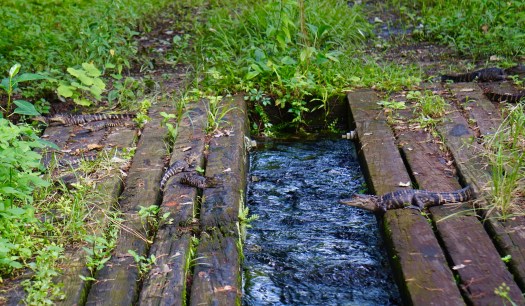
Volunteer Perspective Series
Written by Nan Mattingly
How Florida mottled ducklings helped this CREW Trust volunteer survive quarantine.
Before the governor of Florida imposed a safer-at-home order, I had been experiencing flu symptoms and decided to self-quarantine. So I’ve been pretty isolated since early March.
Fortunately my house is situated on the edge of a fairly large lake, so I’ve long been in the habit of watching activity on the lake. Herons of all types come here to work the banks for small fish; anhingas dive for fish, which are plentiful, and then alight on the banks to dry out their feathers; occasionally I see an osprey snatch up a fish and run; and from time to time I watch long-time resident Wally Gator make his stately way up and down the lake. And of course we have the requisite Muscovy duck population, begging at doors for bread and showing off their unique brand of ugliness.
Right about the time I decided to voluntarily quarantine and cope with what felt like murderous viral symptoms, a miracle occurred: a pair of Florida mottled ducks emerged on my lake with a brood of ten tiny ducklings, just little balls of downy feathers. Though their nest wasn’t very near my house, the whole group took to hanging around my neighbor’s house and mine. Before they showed up, I had only a casual interest in ducks (and a decided dislike for Muscovys). Virus fatigue and a lack of other distractions, I guess, allowed me to become fascinated with the mottled family. Now, about two months after their debut, the ducklings are still a mob of ten and the parents are nowhere to be seen. How they evaded predators is a mystery. Over time I’ve had the privilege of watching them grow, develop their voices, and learn to fly. At the end of May, they’re still there, and behaving like adolescents – chasing each other around, pecking each other on the head and occasionally making test flights across the lake.
Once the little ducklings had attracted my feeble attention, I developed the habit of looking out at the lake first thing every morning to check on them. They tended to arrive in my backyard around 6:30 a.m. Until a few weeks ago, they made tiny little peeping noises, which were charming, but unfortunately they are now developing that distinctive duck voice. On Memorial Day I was awakened early by a chorus of quacking before they did a very patriotic flyover of my lanai.
Anticipating the sad day that my ducklings depart for bigger things, I checked the FWC website to learn when I can expect to become an empty-nester. It was mostly good news. First, I learned that we in south Florida have the pleasure of hosting these ducks year-round; they tend to live south of Tampa and are non-migratory. They are a member of what is called “the mallard complex” which includes about 20 species of ducks, all alike in body shape but distinguished by their feather characteristics and colors. FWC noted that the Florida mottled duck is also known as the “Florida duck” or the “Florida mallard” because they are found only in Florida.
Some people might find a mottled duck’s grey and brown coloring a little boring compared to the mallard, which I now consider to be the designer version of mottled ducks. The mallard has that showy display of teal bordered with white on their wings. Mottled ducks, male and female, have a more subtle version of that coloring on the wings with almost no white showing.

There’s little difference in coloring between male and female mottled ducks, so you have to look at the bills to distinguish them. The male has an olive green-to-yellow bill while the female has an orange-to-brown bill.
Watching the ducklings peck in the grass and dip their bills into the water, I tried to figure out what they were eating. FWC supplied the answer: about 40 percent of their diet comprises insects, snails, mollusks, crayfish and small fish. For the other 60 percent, they eat grass seeds, stems and roots, the seeds of other marsh plants, and bayberries.
I knew that my particular ducklings were special not only for their survival skills and playful personalities, but according to FWC, a female produces only one brood a year and typically lays eight to ten eggs. The mother of my ducklings must have produced a pretty big clutch of eggs, and she must have protected them well. For the first two months or so, the parents hovered over the ducklings and shepherded them around the lake, giving them a good start in life.
It’s not all good news for the Florida mottled duck, however. Go to the FWC website and read about the challenges to the long-term survival of our unique south Florida duck. Loss of wetland habitat, of course, is a big threat. And what FWC calls “feral mallards” have been mating with mottled ducks and producing hybrid offspring.
Having relied on my mottled ducklings to keep me distracted and happy during a tedious quarantine, I’m sorry to contemplate the threats to this special south Florida dabbling duck. We’re still looking for a cure for Covid-19. Watching ducks grow up won’t cure anyone, but it’s a great distraction. Today I’m as healthy as those ten beautiful mottled ducks, and I thank them.












 Visitors will learn about the plants and wildlife of Southwest Florida while participating in a variety of activities and crafts such as palm boots painting, shell necklaces, fishing clinic, paddleboard demonstrations and much more.
Visitors will learn about the plants and wildlife of Southwest Florida while participating in a variety of activities and crafts such as palm boots painting, shell necklaces, fishing clinic, paddleboard demonstrations and much more.